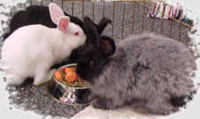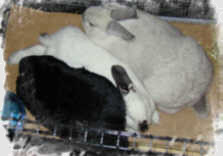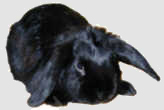
A Rabbit in the House - Now What?
Set your rabbit up for success;
structure his environment so he will succeed.
Cage
The cage will be your rabbit's nest; rabbits usually prefer to have a safe area they can call their own. Set the cage (nest) on the floor, in an area where you spend time, such as the living room or family room. Do not put the cage near a heater or a loud TV or stereo. Always provide shade from a sunny window. When secluded in one room, such as a bedroom, they may be cut off from the family and unsure of the area outside. The more contact you have with your rabbit, the more you will enjoy each other.
The nest should include a litterbox with hay, and food and water bowls. Supply him with safe toys and a bed of synthetic sheepskin from the fabric store. Line the pull out tray with newspaper. Avoid wood shavings. Use a organic litter such as CareFRESH, Yesterday's News or wood stove pellets in the litterbox.
Thumper's New Home
Put Thumper in his nest and close the door for a few hours. Let him get used to the sounds and smells of your home while feeling safe and secure. If he nibbles his food or stretches out, he is relaxing.
Allow a small run area for the first few days. Close off bedrooms or areas where he can get lost. Block access behind refrigerators, washer/dryers and entertainment centers. He should be able to have run time whenever you can supervise him. Put one or more litterboxes in the run area and increase his freedom as he proves himself with his box. Put some hay in the litterbox to encourage him to get in.
Get Down! (on the floor)
Spend a lot of time on your rabbit's level where you are less intimidating. Rabbits are naturally curious and will come up to you eventually. Most rabbits enjoy being petted on the broad part of their head. Snuggling on the floor is usually welcome. If you are holding the rabbit and he struggles, hold him tightly or drop down to your knees and let him go. Do not drop your rabbit as they are very fragile.
Bunny Proof
Rabbits like to chew and dig! Tuck electrical and phone cords out of the way or encase them in clear plastic tubing from the hardware store. Remove books and other desirable items from low shelves. Put houseplants up out of the way. Provide him with a cardboard box of hay to play in. Redirect him to his toys if he is "acting up." Young bunnies are especially exuberant and need to be properly directed.
Active Time
Rabbits are crepuscular, which means that they generally sleep during the day and during the night, but are ready to play at dawn and twilight. So, if you're at work during the day, they won't mind so much being in a cage. But they MUST be let out for at least several hours each day, both to exercise and to have social interaction with you.
Bored rabbits become naughty rabbits. If you're not around to talk to or pet your rabbit as you prepare dinner, watch TV or just read, your rabbit will become very bored. That's when rabbits generally get into trouble by digging in the carpet, chewing on forbidden objects or eating your couch. A very large hole can appear in the carpet in just a few minutes. Young rabbits are generally the ones who get into this type of mischief. So, even if your rabbit starts out this way, you might check every few months to see if she can earn more freedom as she ages. Often, the bathroom, laundry room, kitchen or a bedroom are good, safe places to confine your rabbit while you're away. These rooms are easy to rabbit-proof.
Free run of the house is what we strive for and what many of us are able to achieve. This definitely requires more work on your part. You must inspect every room of your house like a four-star general, looking for wires and other dangerous objects (like plants) that could cause harm to your rabbit. If you have a computer room, you might allow your rabbit access to every room except that one. The more room your rabbit has, the more delightful you will find her as a pet and companion.
Toys
To keep your rabbit occupied and amused, offer toys such as:
- Toilet paper and paper towel rolls
- Newspaper and white scrap paper (ink isn't harmful, just gives dirty feet)
- Straw baskets
- Canning jar rings
- Rolled oats box stuffed with hay
- Soft drink can with pebble inside for noise
- Wire ball with bell inside (sold in stores as a cat or bird toy)
- Cardboard boxes (tape shut then cut small doors)
- Old towels to push around and dig at
Spay/Neuter
Have your rabbit spayed or neutered at about 4-6 months of age by a veterinarian experienced with rabbits. This will help with litterbox training and general behavior.
Outdoor Dangers
Do not leave your rabbit unattended outside as rabbits scare easily and can dig out of a fenced yard. Also, keep them from poisonous plants and pesticides. You can try an "H style" cat harness and a leash, but begin in a safe and familiar area.
Discipline
Never hit a rabbit. They can become very aggressive and angry if provoked. When you find your rabbit doing something that is not allowed, try any or all of the following:
- Clap your hands together to make a loud noise
- Thump your foot like a fellow rabbit
- Whistle loudly
- Shout loudly
Biting
Biting must be stopped as soon as possible. Rabbits do not usually bite because they hate you. There are many reasons within a rabbit's social structure that bring about a bite. For instance, a finger or hand in front of their face may be misinterpreted as a challenge to fight. A rabbit may also accidentally bite when he tries to tug your pant leg and accidentally gets your ankle. Whatever the reason, if you get nipped, let out a shrill cry. Rabbits do this when they are hurt. Since they usually do not intend to hurt you, they will be surprised to find that you have cried out and will usually stop the behavior within a few times.
Your rabbit may be a bit shy at first. Usually within two weeks rabbits begin to feel more secure in their new surroundings. Soon, you will have a rabbit dancing around your home, testing you, seeing what he can get away with!


